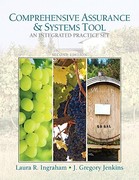Question
(a) Identify the types of costs that would likely be involved in making this product by populating a spreadsheet with the five columns indicated below.
(a)
Identify the types of costs that would likely be involved in making this product by
populating a spreadsheet with the five columns indicated below.
Product Costs
Item
Direct
Materials
Direct
Labor
Manufacturing
Overhead
Period
Costs
I would like to see a minimum of 6 manufacturing overhead costs and 7 period costs.
You should show one line item for both direct materials and direct labor, but please
provide some detail of the costs in parentheses.
Assign hypothetical monthly dollar figures to each costs you identified. The
totals
for
each column must be $360,000 for Direct Materials, $195,000 for direct labor,
$105,000 for Manufacturing Overhead, and $300,000 for period costs.
(b)
Assume you have no raw materials or work in process beginning or ending inventories.
Prepare a projected cost of goods manufactured schedule for the first month.
(c)
You must produce 30,000 robots the first month of operations (November 2020).
Compute the cost to produce one robot.
(d)
What type of cost accounting system will you likely usejob order or process costing?
Explain your answer in a good-sized paragraph!
(e)
Explain, in a good-sized paragraph, how you would assign costs in either the job order
or process costing system you plan to use.
(f)
Classify your costs as either variable or fixed costs. For simplicity, assign all costs to
either variable or fixed, assuming there are no mixed costs, using the format shown.
Item
Variable Costs
Fixed Costs
Total Costs
(g)
Compute the unit variable cost (rounded to two decimal places), using the production
number in (c).
(h)
You will sell 25,000 robots the first month of operations. Set a unit selling price
between $40 and $45 rounded to the nearest whole dollar, and compute both the
contribution margin per unit and the contribution margin ratio.
(i)
Determine your break-even point in dollars and in units.
(j)
Prepare projected operating budgets (sales, production, direct materials, direct labor,
manufacturing overhead, selling and administrative expense, and income statement).
You will need to use the below assumptions for each of the following:
Direct materials
budget:
0.3 Kg of direct materials required to produce one robot;
$40.00 per Kg; desired ending direct materials (assume
none).
Direct labor
budget:
0.65 hours required per robot; rate is $10.00 per hour.
Budgeted income
statement:
Income tax expense is 40% of income from operations.
(k)
Prepare a cash budget for the month. Assume the percentage of sales that will be
collected from customers is 85%, and the percentage of direct materials that will be
paid in the current month is 60%. Income taxes are paid in April.
(l)
The relevant range of activity is from 25,000 to 30,000 robots per month. Recast your
manufacturing overhead budget into a flexible monthly budget for each increment of
1,000 robots produced from 25,000 to 30,000 robots.
(m)
Identify one potential cause of materials, direct labor, and manufacturing overhead
variances for your product.
(n)
Assume that you wish to purchase production equipment that costs $3,000,000.
Determine the cash payback period, utilizing the monthly cash flow that you computed
in part (k) multiplied by 12 months (for simplicity).
(o)
Identify at least three nonfinancial factors that should be considered before
commencing your business venture.
Step by Step Solution
There are 3 Steps involved in it
Step: 1

Get Instant Access to Expert-Tailored Solutions
See step-by-step solutions with expert insights and AI powered tools for academic success
Step: 2

Step: 3

Ace Your Homework with AI
Get the answers you need in no time with our AI-driven, step-by-step assistance
Get Started


